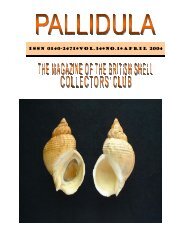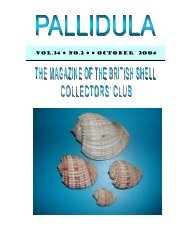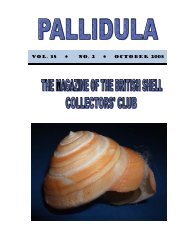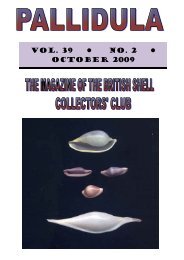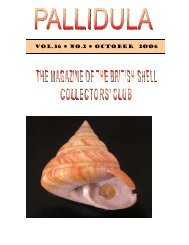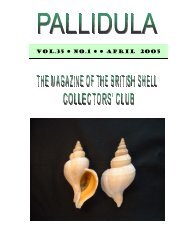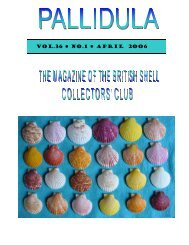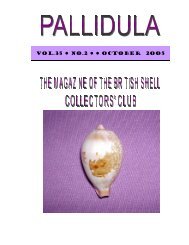VOL.37 NO.1 APRIL 2007 - British Shell Collectors' Club
VOL.37 NO.1 APRIL 2007 - British Shell Collectors' Club
VOL.37 NO.1 APRIL 2007 - British Shell Collectors' Club
Create successful ePaper yourself
Turn your PDF publications into a flip-book with our unique Google optimized e-Paper software.
PALLIDULA Page 16<br />
Diagnosing subspecies<br />
characteristics –<br />
main diagnostic shell characteristics (MDSC)<br />
taxon↓ dorsum base and margins interstices of teeth<br />
E. onyx onyx<br />
brown with two white<br />
broad longitudinal bands<br />
dark brown to black<br />
dark brown to black<br />
E. onyx adusta<br />
tinged light to dark brown<br />
without white bands<br />
brown<br />
brown to dark brown<br />
E. onyx melanesiae<br />
tinged light to dark brown<br />
without white bands<br />
brown to dark brown<br />
brown to dark brown<br />
It is interesting to mention that the shells of the two peripheral subspecies separated geographically by the vast<br />
area of the Indian Ocean – E. onyx adusta and E. onyx melanesiae – are almost identical and they are<br />
practically not separable without knowing the exact locality, their base and dorsum are tinged light to dark<br />
brown. It is possible that in the future, when more conchological information is available, they will be united in<br />
one subspecies.<br />
<strong>Shell</strong>s in intermediate zones connecting all subspecies of E. onyx have sometimes mixed characters: in the<br />
same area entirely brown shells can be found together with shells having whitish transverse dorsal bands or<br />
whitish longitudinal dorsal bands of different width. There are reports in the literature regarding finding of<br />
several entirely brown shells in Southern Thailand and these shells were for some time treated as E. onyx<br />
melanesiae. Until now, there is no conchological evidence confirming the existence of another species in the<br />
onyx-group, separated from E. onyx by a conchological gap without intermediates. A conclusion can be drawn<br />
that Erronea succincta must remain a synonym of Erronea onyx.<br />
The taxonomic history of E. nymphae is discussed in Heiman (2006). This taxon is perhaps a mutant and can<br />
be treated as a form until more information confirms the existence of its living population is known. The five<br />
nymphae-like shells mentioned in Sowerby (1870) are still preserved in Mss Saul’s collection, now in the<br />
Zoological Museum of the Cambridge University.<br />
Literature<br />
Dodge, H. 1953. A historical review of the mollusks of Linnaeus. Part 2. The class Cephalopoda and the genera<br />
Conus and Cypraea of the class Gastropoda. Bulletin of the American Museum of Natural History 103(1). New<br />
York. 134 pp.<br />
Heiman, E.L. 2006. Intraspecific variation in living cowries. Part 2. An electronic book on a CD.<br />
Lorenz F. & Hubert, A. 1993. A Guide to worldwide Cowries. 571 pp. Christa Hemmen Verlag, Wiesbaden,<br />
Germany.<br />
Raybaudi, L.M. 1989a. Cypraeidae:genus Erronea-subgenus Adusta. For a revision of the onyx group. TC 21:2-<br />
3.1989b. Cypraeidae (Subgenus Adusta Jousseaume, 1884). TC 21:4-10.<br />
Schilder F.A. & Schilder, M. 1938. Prodrome of a monograph on living Cypraeidae. Proceedings of the<br />
Malacological Society of London 23:119-231.<br />
Schilder M. & Schilder F.A., 1971. A catalogue of living and fossil cowries. Institut Royal des sciences naturelles<br />
de Belgique. 246 pp.<br />
Sowerby, G. B. I. 1870. Thesaurus Conchilyorum Vol. 4.<br />
* e-mail address of the author: heimel@netvision.net.il



